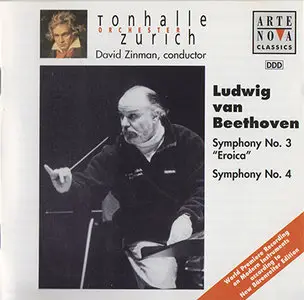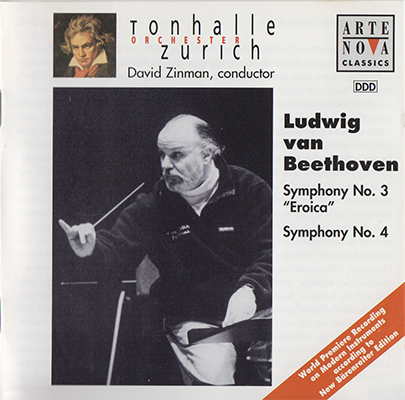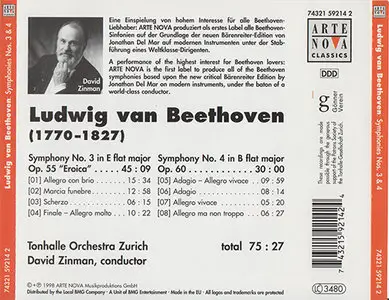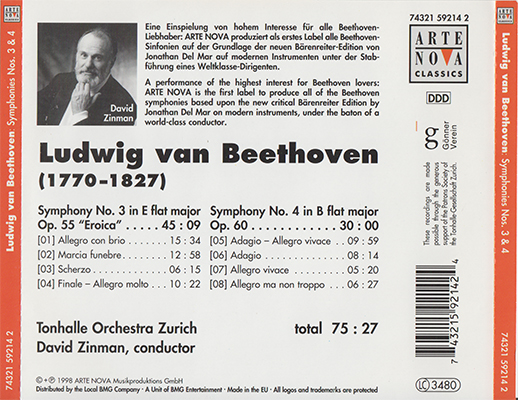Ludwig van Beethoven - Symphony No. 3 & No. 4
Tonhalle Orchestra Zurich / David Zinman
EAC+LOG+CUE | FLAC: 307 MB | Full Artwork: 66 MB | 5% Recovery Info
Label/Cat#: Arte Nova # 74321 59214 2 | Country/Year: Germany 1998
Genre: Classical | Style: Classical Period
MD5 [X] CUE [X] LOG [X] INFO TEXT [X] ARTWORK [X]
my rip [X] not my rip [ ]
Exact Audio Copy V1.0 beta 3 from 29. August 2011
EAC extraction logfile from 15. July 2013, 15:31
Zinman, TonhalleOrch. Zürich / Beethoven: Symphonien Nr. 3 & 4
Used drive : PIONEER BD-RW BDR-206 Adapter: 0 ID: 2
Read mode : Secure
Utilize accurate stream : Yes
Defeat audio cache : Yes
Make use of C2 pointers : No
Read offset correction : 667
Overread into Lead-In and Lead-Out : No
Fill up missing offset samples with silence : Yes
Delete leading and trailing silent blocks : No
Null samples used in CRC calculations : Yes
Used interface : Native Win32 interface for Win NT & 2000
Used output format : User Defined Encoder
Selected bitrate : 1024 kBit/s
Quality : High
Add ID3 tag : Yes
Command line compressor : C:\Program Files\FLAC\flac.exe
Additional command line options : -5 -T "Artist=%artist%" -T "Title=%title%" -T "Album=%albumtitle%" -T "Date=%year%" -T "Tracknumber=%tracknr%" -T "Genre=%genre%" %source% -o %dest%
TOC of the extracted CD
Track | Start | Length | Start sector | End sector
––––––––––––––––––––––––––––-
1 | 0:00.32 | 15:36.50 | 32 | 70281
2 | 15:37.07 | 12:59.00 | 70282 | 128706
3 | 28:36.07 | 6:15.50 | 128707 | 156881
4 | 34:51.57 | 10:31.50 | 156882 | 204256
5 | 45:23.32 | 10:01.13 | 204257 | 249344
6 | 55:24.45 | 8:15.62 | 249345 | 286531
7 | 63:40.32 | 5:19.38 | 286532 | 310494
8 | 68:59.70 | 6:26.62 | 310495 | 339506
Range status and errors
Selected range
Filename F:\=== VINYL RIPS ===\=== EAC===\X FRESH RIP\Beethoven- Zinman, TonhalleOrch. Zürich - Symphonien Nr. 3 & 4.wav
Peak level 98.9 %
Extraction speed 8.2 X
Range quality 100.0 %
Test CRC 8BB31A6E
Copy CRC 8BB31A6E
Copy OK
No errors occurred
AccurateRip summary
Track 1 accurately ripped (confidence 11) [F055ACC7] (AR v2)
Track 2 accurately ripped (confidence 11) [51B1CB39] (AR v2)
Track 3 accurately ripped (confidence 11) [492A7867] (AR v2)
Track 4 accurately ripped (confidence 11) [CF4148B9] (AR v2)
Track 5 accurately ripped (confidence 11) [1737063C] (AR v2)
Track 6 accurately ripped (confidence 9) [865B676A] (AR v2)
Track 7 accurately ripped (confidence 11) [F4504E64] (AR v2)
Track 8 accurately ripped (confidence 10) [32B7EBB4] (AR v2)
All tracks accurately ripped
End of status report
–– CUETools DB Plugin V2.1.3
[CTDB TOCID: tGsZmPRky_iQxRfHpdLcp2HMZJU-] found, Submit result: discs with pregaps not supported in this protocol version
[deb2f6f9] (121/121) Differs in 17887 samples @00:00:13-00:00:42
You can use CUETools to repair this rip.
==== Log checksum A3D08B5AD127B4BB9513EB1A0BEA56386395ADBEEE5D214C0C7D295A881C115A ====
EAC extraction logfile from 15. July 2013, 15:31
Zinman, TonhalleOrch. Zürich / Beethoven: Symphonien Nr. 3 & 4
Used drive : PIONEER BD-RW BDR-206 Adapter: 0 ID: 2
Read mode : Secure
Utilize accurate stream : Yes
Defeat audio cache : Yes
Make use of C2 pointers : No
Read offset correction : 667
Overread into Lead-In and Lead-Out : No
Fill up missing offset samples with silence : Yes
Delete leading and trailing silent blocks : No
Null samples used in CRC calculations : Yes
Used interface : Native Win32 interface for Win NT & 2000
Used output format : User Defined Encoder
Selected bitrate : 1024 kBit/s
Quality : High
Add ID3 tag : Yes
Command line compressor : C:\Program Files\FLAC\flac.exe
Additional command line options : -5 -T "Artist=%artist%" -T "Title=%title%" -T "Album=%albumtitle%" -T "Date=%year%" -T "Tracknumber=%tracknr%" -T "Genre=%genre%" %source% -o %dest%
TOC of the extracted CD
Track | Start | Length | Start sector | End sector
––––––––––––––––––––––––––––-
1 | 0:00.32 | 15:36.50 | 32 | 70281
2 | 15:37.07 | 12:59.00 | 70282 | 128706
3 | 28:36.07 | 6:15.50 | 128707 | 156881
4 | 34:51.57 | 10:31.50 | 156882 | 204256
5 | 45:23.32 | 10:01.13 | 204257 | 249344
6 | 55:24.45 | 8:15.62 | 249345 | 286531
7 | 63:40.32 | 5:19.38 | 286532 | 310494
8 | 68:59.70 | 6:26.62 | 310495 | 339506
Range status and errors
Selected range
Filename F:\=== VINYL RIPS ===\=== EAC===\X FRESH RIP\Beethoven- Zinman, TonhalleOrch. Zürich - Symphonien Nr. 3 & 4.wav
Peak level 98.9 %
Extraction speed 8.2 X
Range quality 100.0 %
Test CRC 8BB31A6E
Copy CRC 8BB31A6E
Copy OK
No errors occurred
AccurateRip summary
Track 1 accurately ripped (confidence 11) [F055ACC7] (AR v2)
Track 2 accurately ripped (confidence 11) [51B1CB39] (AR v2)
Track 3 accurately ripped (confidence 11) [492A7867] (AR v2)
Track 4 accurately ripped (confidence 11) [CF4148B9] (AR v2)
Track 5 accurately ripped (confidence 11) [1737063C] (AR v2)
Track 6 accurately ripped (confidence 9) [865B676A] (AR v2)
Track 7 accurately ripped (confidence 11) [F4504E64] (AR v2)
Track 8 accurately ripped (confidence 10) [32B7EBB4] (AR v2)
All tracks accurately ripped
End of status report
–– CUETools DB Plugin V2.1.3
[CTDB TOCID: tGsZmPRky_iQxRfHpdLcp2HMZJU-] found, Submit result: discs with pregaps not supported in this protocol version
[deb2f6f9] (121/121) Differs in 17887 samples @00:00:13-00:00:42
You can use CUETools to repair this rip.
==== Log checksum A3D08B5AD127B4BB9513EB1A0BEA56386395ADBEEE5D214C0C7D295A881C115A ====
foobar2000 1.1.14a / Dynamic Range Meter 1.1.1
log date: 2013-07-16 22:38:54
––––––––––––––––––––––––––––––––––––––––
Analyzed: Zinman, TonhalleOrch. Zürich / Beethoven: Symphonien Nr. 3 & 4
––––––––––––––––––––––––––––––––––––––––
DR Peak RMS Duration Track
––––––––––––––––––––––––––––––––––––––––
DR14 -0.25 dB -20.22 dB 15:37 01-Symphonie Nr. 3 Es-dur op. 55 'Eroica' - 1. Allegro con brio
DR14 -0.10 dB -21.96 dB 12:59 02-Symphonie Nr. 3 Es-dur op. 55 'Eroica' - 2. Marcia funebre
DR14 -0.10 dB -21.36 dB 6:16 03-Symphonie Nr. 3 Es-dur op. 55 'Eroica' - 3. Scherzo
DR14 -1.59 dB -20.65 dB 10:32 04-Symphonie Nr. 3 Es-dur op. 55 'Eroica' - 4. Allegro molto
DR15 -0.43 dB -20.52 dB 10:01 05-Symphonie Nr. 4 B-dur op. 60 - 1. Adagio - Allegro vivace
DR15 -1.80 dB -23.80 dB 8:16 06-Symphonie Nr. 4 B-dur op. 60 - 2. Adagio
DR14 -2.81 dB -22.01 dB 5:20 07-Symphonie Nr. 4 B-dur op. 60 - 3. Allegro vivace
DR16 -0.09 dB -20.90 dB 6:27 08-Symphonie Nr. 4 B-dur op. 60 - 4. Allegro ma non troppo
––––––––––––––––––––––––––––––––––––––––
Number of tracks: 8
Official DR value: DR15
Samplerate: 44100 Hz
Channels: 2
Bits per sample: 16
Bitrate: 542 kbps
Codec: FLAC
================================================================================
log date: 2013-07-16 22:38:54
––––––––––––––––––––––––––––––––––––––––
Analyzed: Zinman, TonhalleOrch. Zürich / Beethoven: Symphonien Nr. 3 & 4
––––––––––––––––––––––––––––––––––––––––
DR Peak RMS Duration Track
––––––––––––––––––––––––––––––––––––––––
DR14 -0.25 dB -20.22 dB 15:37 01-Symphonie Nr. 3 Es-dur op. 55 'Eroica' - 1. Allegro con brio
DR14 -0.10 dB -21.96 dB 12:59 02-Symphonie Nr. 3 Es-dur op. 55 'Eroica' - 2. Marcia funebre
DR14 -0.10 dB -21.36 dB 6:16 03-Symphonie Nr. 3 Es-dur op. 55 'Eroica' - 3. Scherzo
DR14 -1.59 dB -20.65 dB 10:32 04-Symphonie Nr. 3 Es-dur op. 55 'Eroica' - 4. Allegro molto
DR15 -0.43 dB -20.52 dB 10:01 05-Symphonie Nr. 4 B-dur op. 60 - 1. Adagio - Allegro vivace
DR15 -1.80 dB -23.80 dB 8:16 06-Symphonie Nr. 4 B-dur op. 60 - 2. Adagio
DR14 -2.81 dB -22.01 dB 5:20 07-Symphonie Nr. 4 B-dur op. 60 - 3. Allegro vivace
DR16 -0.09 dB -20.90 dB 6:27 08-Symphonie Nr. 4 B-dur op. 60 - 4. Allegro ma non troppo
––––––––––––––––––––––––––––––––––––––––
Number of tracks: 8
Official DR value: DR15
Samplerate: 44100 Hz
Channels: 2
Bits per sample: 16
Bitrate: 542 kbps
Codec: FLAC
================================================================================
CD Info:
Ludwig van Beethoven - Symphony No. 3 & No. 4
Tonhalle Orchestra Zurich / David Zinman
Label: Arte Nova Classics
Catalog#: 74321 59214 2
Format: CD, Album
Country: Germany
Released: 1998
Genre: Classical
Style: Classical Period
Tracklist:
1 Symphonie Nr. 3 Es-dur op. 55 'Eroica' - 1. Allegro con brio 15:37
2 Symphonie Nr. 3 Es-dur op. 55 'Eroica' - 2. Marcia funebre 12:59
3 Symphonie Nr. 3 Es-dur op. 55 'Eroica' - 3. Scherzo 6:16
4 Symphonie Nr. 3 Es-dur op. 55 'Eroica' - 4. Allegro molto 10:32
5 Symphonie Nr. 4 B-dur op. 60 - 1. Adagio - Allegro vivace 10:01
6 Symphonie Nr. 4 B-dur op. 60 - 2. Adagio 8:16
7 Symphonie Nr. 4 B-dur op. 60 - 3. Allegro vivace 5:20
8 Symphonie Nr. 4 B-dur op. 60 - 4. Allegro ma non troppo 6:27
about the complete symphony cycle: These celebrated performances have been universally welcomed by critics of every persuasion, and praised for their freshness, their polish, and their scholarly approach. Hearing them again persuades me to salute them as, in many ways, the ideal recording of this much-recorded repertory: the one which most perfectly integrates old-school weight and dynamism with the lessons we've all learnt, since the 1980s, from historically-informed original-instrument performances.
Using the Jonathan Del Mar Urtext edition, published by Bärenreiter, these performances steal the occasional surprise on an unsuspecting listener, with some notes and numerous articulations notably at variance with traditional texts. But we mustn't make the mistake of imagining that this gives them some kind of biblical authority. As ever in Beethoven - as ever in all music - the conductor needs to decipher the composer's instructions, or lack of them, make sense of often-conflicting information, and provide his own bowing, his own dynamics and his own phrasing. And Zinman's obviously worked overtime to ensure that, in the spirit of Del Mar's edition, we hear exactly what Beethoven wanted us to hear.
Of course Zinman's not alone in prizing that objective. The challenge in conducting Beethoven is deciding what's most important in any one situation. Dynamics have to be perpetually adjusted - most commonly, noisy trumpets and horns need to be piped down to enable more fragile voices, but more important information, to penetrate. And, commonly, making this kind of adjustment in favour of thematic detail ruins the effect of an all-important climax. Too often in Beethoven, the interpreter will have to settle for 'loud' - i.e. as loud as the composer appears to have wanted it - or 'clear' - i.e. significant detail being audible - but accept that it can't always be both. It may appear to be outrageously controversial to say so but in fact it's stating the truth, and indeed the obvious, that, when writing for the orchestra, Beethoven's workmanship was often crude - certainly his finishing, and his attention to detail or everyday practicalities.
Zinman's formula is to balance textures in such a way that we are able to follow the argument without sacrificing weight or excitement. The modest size of his orchestra enables him to do this, but it mainly comes down to making inspired decisions in resolving the innumerable enigmas and dilemmas Beethoven leaves us with. With hardly any exceptions (the Fifth Symphony, perhaps, but more about this later) it's all gain and no loss.
What you always get in these performances is excellent orchestral playing, incisive articulation, carefully voiced textures, a cracking pace, and agreeable surprises here there and everywhere. Over and over again, phrases are shaped in a novel way, note lengths are unlike we've heard them before, and woodwinds are left to ornament a once-familiar line: the solo oboe free-time links in the first movements of the Fifth and Seventh, for example, are extended into mini-cadenzas, and most persuasively done. These are invariably arresting performances - powerful, without being heavyweight. My copious notes repeatedly include words like agile, athletic, sprightly, alive, youthful, vigorous and energetic.
In one area of potential controversy - his widespread adoption of fast tempi - Zinman is by no means alone among modern recorded performances. The first movement of the Third is startlingly quick, but it differs from most others that are similarly rapid (Bernstein's inspired CBS/NYPO performance, for example, or even the celebrated [Erich] Kleiber mono recording on Decca with the Vienna Philharmonic) in finding room to shape phrases, and to breathe, despite the sheer pace. The Allegretto slow movement of the Seventh is - you may think, as I am tempted to… - hurried to the point of sounding casual, of belittling a great statement. Similarly, perhaps, the slow movement of the Ninth, which, however beautiful, surely loses expressive composure at this pace. But this is becoming the norm nowadays, and no longer exceptional! The most notable beneficiaries of this approach are the scherzos of all symphonies. That in the Fifth works particularly well, with an agility and fleetness of foot which is most infectious: those in the Sixth and Seventh are outstandingly alive. However, the one-in-a-bar trios of the scherzos in both the Seventh and the Ninth are truly hectic, and even I find these difficult to accept.
It's worth remembering that the metronome wasn't invented until 1811 or thereabouts - the slow movement of the Eighth celebrates it, remember - and that Beethoven's markings dating from the years of his advancing deafness are mostly retrospective. I'm not the first person to question their 'authority'!
One curious aspect of Zinman's conducting deserves a special mention. Horns and trumpets in Beethoven's day weren't chromatic instruments, because they pre-date the invention of the valve. In fact the long solo for the 4th[!] horn in the Ninth's slow movement is a marker, if you like, for that seminal transition between diatonic 18th century brass and chromatic 19th century brass! So they played only the notes of the harmonic series - tonics, dominants, triads - like the Eroica's first movement main theme - and what-have-you, plus a few others, mostly higher up the pitch range, which were out of tune, and had to be hand-stopped to bring them into line - a technique which drastically impaired the instrument's tonal character and polish, especially in forte and fortissimo. Whereas Mahler (among others) used stopped horns for special and usually menacing effect, hand-horn players in Beethoven's day tried to disguise such stopped notes so that listeners would be largely unaware of the difference between 'natural' (i.e. open, or normal) and 'un-natural' (i.e. stopped, or adjusted) notes - as, for example, in Gardiner's or Norrington's CD recordings with their 'original instrument' orchestras. Zinman, with his modern instruments, recognises this characteristic by, for me, eccentrically, encouraging his players to modify notes outside the harmonic series with a full Mahlerian stopped tone, rather than the subtle adaptation you'd get from a seasoned hand-horn player. This makes for alarming tonal discrepancies, often in the middle of a phrase, and for no good other than nominally technical reason.
A few highlights. The trills in the Second's slow introduction are as you've never heard them before - tremendous fun, and doubtless the result of painstaking rehearsal! The last movement of the Seventh is breathlessly energetic: it sweeps you away! The hilarious discourse of upper and lower strings at the beginning of the development section, where Beethoven throws us completely off tonal course, speaks to us like a spontaneous comic recitative - tremendously involving, and wholly convincing! The Eighth - Beethoven's 'little' symphony - is full of good humour, emerging very fittingly as a chamber symphony, and enlightened by all manner of touches and affectionate detail. How refreshing, especially after Gardiner's relentless, almost merciless, approach, which seems increasingly to be the done thing these days. In the 'introduction' to the Ninth, how nice to hear genuine sextuplets, clearly annunciated: no Brucknerian tremolos here!
May be the Fifth works least well. It's athletic and manly, but it has a lightness of touch which we don't associate with this hard-hitting historic statement. The amount of detail Zinman brings out enables us to hear it afresh - indeed we are made to realise what we so often miss! - so we shouldn't rule it out of court simply because it lacks the Klemperian weight we expect of it. To compare it with the classic [Carlos] Kleiber/VPO Fifth - which I've always been tempted to regard as definitive - is to compare Olympic sprinters and Olympic weight-lifters.
The Ninth makes for a strong conclusion to the set, but it perhaps lacks the grandeur of more traditional performances. It's powerful, meticulously prepared, and deeply committed, but it doesn't belong in the mighty Klemperer-Karajan dynasty. That will be a plus point to some, and a minus point to others. The young-sounding soloists are excellent as a quartet, especially the soprano, but aren't ideal in their solo numbers: the tenor sounds breathless and lightweight at Zinman's pace, and the bass is hardly commanding enough at his entry to be credible as a silencer of the orchestra's din. The chorus is excellent.
By the way, Arte Nova gives you two versions of the Ninth's finale. The alternative includes a G.P. bar (General Pause) before the word "Bruder", which Beethoven later and mysteriously removed. Not a big deal, I'd say. Personally, I wish Beethoven had left revised versions of all nine symphonies, with answers to all the interpretative questions we've spent 180 years grappling with! (Only joking: what sort of a music-lover's world would it be where all Beethoven symphony recordings were the same?)
The discs are all available singly, as detailed above. In fact buying the set only entails a cardboard box containing the five individual CDs, complete with their separate booklets. If you're wanting just a First and a Second, I'd say this is the one. It perfectly portrays a growing composer bursting confidently out of the gates of the 18th century, and into a dawning new age. The two finest performances of the set, the Third and the Fourth, are paired on a single disc, which embraces every human emotion, and speaks with a uniquely authoritative voice. The Eroica boasts a mighty first movement, a solemn Funeral March, a nimble Scherzo (with wonderful horn playing) and a grandly-conceived variation finale. The Fourth has explosive energy without ever being overstated, and (in its slow movement) some of the most tender playing in the entire cycle. Take it from me: there is no better Beethoven symphony disc than this in the recorded music catalogues of all time!
This set deserves the most enthusiastic recommendation which words can muster. It has few rivals even in the top price range. The most recent Abbado? Certainly the Gardiner. And the Vänskä Minnesota set, when (if ever) it's complete, will take some beating. In its price range, the Drahos (on Naxos) is good, but not quite in this league: likewise the Norrington, now available on Virgin for silly money, and very tempting. But Zinman is Beethoven: I can pay him no greater compliment. - Peter J Lawson, MusicWeb International







